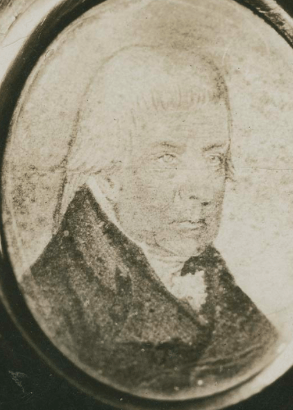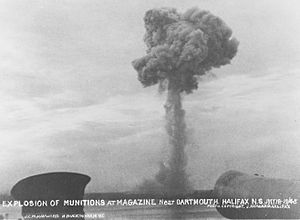History of Dartmouth, Nova Scotia facts for kids
Dartmouth, founded in 1750, is a community in the Canadian province of Nova Scotia. It's part of the larger Halifax Regional Municipality (HRM). Dartmouth and its neighbour, Halifax, are the main urban areas of the HRM. Both Dartmouth and Halifax, along with the town of Bedford and the County of Halifax, joined together on April 1, 1996, to form the HRM.
Contents
Mi'kmaq History in Dartmouth
Before Europeans arrived, the Mi'kmaq people lived in the area around Dartmouth for about a thousand years. They called this place Ponamogoatitjg (Boonamoogwaddy). This name means "Tomcod Ground" or "Salmon Place," because of the fish found in Halifax Harbour.
The Mi'kmaq often spent their summers near the Bedford Basin. They would move inland before the cold Atlantic winter. From Dartmouth Cove, they used canoe routes through the Dartmouth lakes to the Sipekne'katik (Shubenacadie) waterway.
The British wanted to build a settlement in this area (Dartmouth/Halifax). This was a plan to control Acadia and win against France in North America. The Mi'kmaq believed that building Dartmouth broke earlier agreements with the British. Because of this, the Mi'kmaq, along with Acadian and Maliseet groups, attacked the new settlement several times.
One of the last Mi'kmaq communities in Halifax was at Turtle Grove, near Tuft's Cove. Sadly, it was destroyed during the Halifax Explosion on December 6, 1917. Today, the Millbrook First Nation has a small reserve in Cole Harbour, on the eastern edge of Dartmouth.
Eighteenth Century Life
Early Conflicts: Father Le Loutre's War
Even though the British took over Acadia in 1710, Nova Scotia was still mostly home to Catholic Acadians and Mi'kmaq. Father Le Loutre's War began when Edward Cornwallis arrived on June 21, 1749, to start Halifax. By building Halifax without talking to them, the British broke earlier agreements with the Mi'kmaq.
The British quickly started building other settlements. To protect these new Protestant settlements from Mi'kmaq, Acadian, and French attacks, they built forts. These forts were in Halifax (1749), Bedford (Fort Sackville) (1749), Dartmouth (1750), Lunenburg (1753), and Lawrencetown (1754). During this war, Dartmouth was attacked eight times.
In August 1750, a ship called the Alderney arrived with 353 new settlers. Officials in Halifax decided these new people should settle on the eastern side of Halifax Harbour. The community was later named Dartmouth. This name honoured William Legge, 1st Earl of Dartmouth, a former British government official.
First Attacks on Dartmouth (1749-1750)
The Mi'kmaq saw the founding of Halifax without discussion as breaking past agreements. On September 24, 1749, the Mi'kmaq officially said they were against the British settlement plans. Just six days later, on September 30, 1749, about forty Mi'kmaq attacked six men cutting trees in Dartmouth. Four men were killed, one was captured, and one escaped to raise the alarm. This was the first of eight attacks on Dartmouth.
After this attack, on October 2, 1749, Governor Cornwallis offered a reward for every Mi'kmaq. To help with this, two companies of New England Rangers were formed. These groups searched the land around Halifax for Mi'kmaq.
In July 1750, the Mi'kmaq killed seven men working in Dartmouth. In August 1750, the 353 people from the Alderney started the town of Dartmouth. The town was planned out that autumn. The next month, on September 30, 1750, Dartmouth was attacked again. Five more residents were killed. In October 1750, a group of eight men went hunting and were captured by the Mi'kmaq.
More Attacks on Dartmouth (1751)

The next year, on March 26, 1751, the Mi'kmaq attacked again. They killed fifteen settlers and wounded seven others, three of whom later died. They also took six people captive. Soldiers who chased the Mi'kmaq fell into a trap, and one sergeant was killed. Two days later, on March 28, 1751, the Mi'kmaq captured three more settlers.
Three months later, on May 13, 1751, a leader named Broussard led sixty Mi'kmaq and Acadians to attack Dartmouth again. This event became known as the "Dartmouth Massacre." Broussard and his group killed twenty settlers and took more prisoners. A sergeant was also killed. They destroyed buildings. The British later reported killing six Mi'kmaq warriors.
French and Indian War
By June 1757, settlers had to completely leave the community of Lawrencetown. This was because there were so many attacks that people couldn't leave their homes safely. In nearby Dartmouth, in the spring of 1759, the Mi'kmaq attacked Eastern Battery. Five soldiers were killed in this attack.
The Quakers Arrive
Dartmouth grew slowly. In 1785, after the American Revolution, a group of Quakers from Nantucket came to Dartmouth. They wanted to start a whaling business. They built homes, a Quaker meeting house, a dock for their ships, and a factory. This factory made candles and other products from whale oil.
This business was successful, and the Quakers hired many local people. However, within ten years, around 1795, the whalers moved their business to Wales. Only one Quaker home in Dartmouth is still preserved today. It is thought to be the oldest building in Dartmouth.
Loyalist Settlers
Other families soon arrived in Dartmouth. Among them were the Hartshorne family, who were Loyalists (people who supported Britain during the American Revolution). They arrived in 1785 and received land that included areas near today's Portland, King, and Wentworth Streets.
Woodlawn was once part of land bought by another Loyalist named Ebenezer Allen. He became an important businessman in Dartmouth. In 1786, he gave land near his property to be used as a cemetery. Many early settlers are buried in the Woodlawn cemetery. This includes the "Babes in the Woods," two sisters who got lost in the forest and died.
Nineteenth Century Growth
By the early 1800s, Dartmouth was a small community of about twenty-five families. They worked at a sawmill and farmed to support Halifax. However, in the mid-1800s, Dartmouth grew quickly. This growth started with the building of the Shubenacadie Canal in the 1820s. More importantly, successful factories like the Dartmouth Marine Slips, founded in 1850, helped the town grow.
Within twenty years, Dartmouth had sixty houses, a church, a mill, shipyards, a sawmill, two inns, and a bakery near the harbour. In 1860, Starr Manufacturing Company started operating near the Shubenacadie Canal. This factory employed over 150 workers. It made some of the world's first mass-produced ice skates. They also made cut nails, vault doors, iron bridge parts, and other heavy iron products.
The Mott's candy and soap factory, which employed 100 people, opened in Hazelhurst. The Stairs Ropeworks, later called Consumer Cordage, was a rope factory on Wyse Road. It offered jobs to over 300 people and created its own neighbourhood for workers. The Symonds Foundry employed another 50 to 100 people. As the population grew, more houses were built, and new businesses started. Neighbourhoods like Woodlawn, Woodside, and Westphal grew on the edges of the town.
The Tallahassee Escape
During the American Civil War, on August 18, 1864, a Confederate ship called the CSS Tallahassee sailed into Halifax harbour. It needed supplies, coal, and repairs to its main mast. The ship started loading coal at Woodside, on the Dartmouth shore. Two Union ships, the Nansemont and the Huron, were getting close to the Tallahassee.
The captain of the Tallahassee, John Taylor Wood, was offered an escort out of the harbour. Instead, he secretly left the harbour at night. He used the seldom-used Eastern Passage between McNab’s Island and the Dartmouth Shore. This channel was narrow and tricky with shallow tides. So, Wood hired a local pilot named Jock Flemming. The Tallahassee left the Woodside dock at 9:00 p.m. on August 19. All its lights were out. People on the Eastern Passage mainland could see the dark ship moving through the water, successfully avoiding capture.
Becoming a Town
In 1873, Dartmouth officially became a town. A Town Hall was built in 1877. In 1883, "The Dartmouth Times" newspaper began publishing. In 1885, a railway station was built. The first passenger train service started in 1886. Branch lines were added to Windsor Junction by 1896 and the Eastern Shore by 1904.
There were two attempts in the 1880s to build a railway bridge across The Narrows of Halifax Harbour. But strong storms washed them away. These plans were stopped after the line to Windsor Junction was finished. The railway line through Dartmouth was meant to continue along the Eastern Shore to Canso or Guysborough. However, developers built it inland along the Musquodoboit River to Musquodoboit Harbour. It ended in the farming community of Upper Musquodoboit. This ended Dartmouth's dream of becoming a major railway centre.
Twentieth Century Events
Halifax Explosion Impact
The Dartmouth side of the harbour was not as crowded as Halifax. It was also separated from the blast by the width of the harbour. However, Dartmouth still suffered a lot of damage. It's estimated that almost 100 people died on the Dartmouth side. Windows were broken, and many buildings were damaged or destroyed. This included the Oland Brewery and parts of the Starr Manufacturing Company. Nova Scotia Hospital was the only hospital on the Dartmouth side. Many victims were treated there.
Bedford Magazine Explosion
During World War II, Dartmouth, like Halifax, was very busy supporting Canada's war efforts. On July 18, 1945, near the end of the war, a fire started at the magazine jetty on the Bedford Basin, north of Dartmouth. The fire began on a sunken barge and quickly spread to the dock. A series of huge explosions happened as stored ammunition blew up. The barge that started the explosion still lies on the seabed near the eastern shore by the Magazine Dock.
Postwar Growth
Dartmouth grew very quickly after 1954. That's when the Angus L. Macdonald Bridge opened, finally giving a direct road link to Halifax. The bridge allowed for fast growth of new neighbourhoods. It also led to the building of shopping centres, like the first Dartmouth Shopping Centre and Mic Mac Mall.
Becoming the City of Dartmouth
In 1961, the communities of Woodlawn, Woodside, and Westphal joined with the town of Dartmouth. Together, they became the "City of Dartmouth." It was the third-largest city in Nova Scotia, after Halifax and Sydney.
Joining the Halifax Regional Municipality
In the 1990s, Dartmouth, like many other Canadian cities, joined with its surrounding areas under one local government. The provincial government wanted to reduce the number of local governments to save money. So, they created a group in 1992 to plan this.
In 1995, a law was passed to create the Halifax Regional Municipality (HRM). The HRM officially started on April 1, 1996. It brought together all the local governments in Halifax County. This included the cities of Halifax and Dartmouth, the town of Bedford, and the Municipality of the County of Halifax. Dartmouth still keeps its name and identity. People living in the Dartmouth area are still called "Dartmouthians." The regional municipality is often called by its full name or "HRM," especially in the news.


